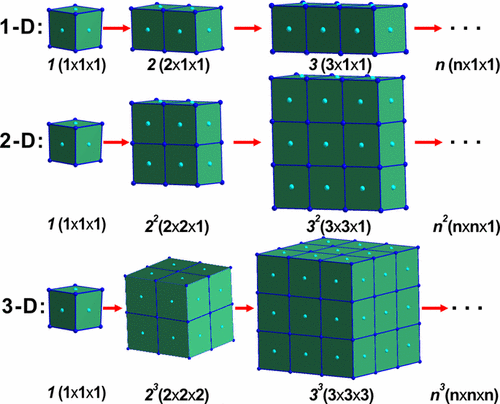当前位置:
X-MOL 学术
›
Inorg. Chem.
›
论文详情
Our official English website, www.x-mol.net, welcomes your
feedback! (Note: you will need to create a separate account there.)
Supercubes, Supersquares, and Superrods of Face-Centered Cubes (FCC): Atomic and Electronic Requirements of [Mm(SR)l(PR′3)8]q Nanoclusters (M = Coinage Metals) and Their Implications with Respect to Nucleation and Growth of FCC Metals
Inorganic Chemistry ( IF 4.3 ) Pub Date : 2017-09-15 00:00:00 , DOI: 10.1021/acs.inorgchem.7b00427 Boon K. Teo 1 , Huayan Yang 1 , Juanzhu Yan 1 , Nanfeng Zheng 1
Inorganic Chemistry ( IF 4.3 ) Pub Date : 2017-09-15 00:00:00 , DOI: 10.1021/acs.inorgchem.7b00427 Boon K. Teo 1 , Huayan Yang 1 , Juanzhu Yan 1 , Nanfeng Zheng 1
Affiliation

|
Understanding the nucleation and growth pathways of nanocrystallites allows precise control of the size and shape of functional crystalline nanomaterials of importance in nanoscience and nanotechnology. This paper provides a detailed analysis of the stereochemical and electronic requirements of three series of nanoclusters based on face-centered cubes (fcc) as the basic building blocks, namely, 1-, 2-, and 3-D assemblages of fcc to form superrods (n), supersquares (n2), and supercubes (n3). The generating functions for calculating the numbers (and arrangements) of surface and interior metal atoms, as well as the number and dispositions of the ligands, for these particular sequences of fcc metal clusters of the general formula [Mm(SR)l(PR′3)8]q (where M = coinage metals; SR = thiolates (or group XI ligands), and PR′3 = phosphines) are presented. An electron-counting scheme based on the jelliumatic shell nodel, a variant of the jellium model, predicts the electron requirements and hence the chemical compositions that are critical in the design and synthesis of the next generation of giant nanoclusters in the nanorealm. The ligand binding specificities, which are keys to effective surface ligand control of the size and shape of these nanoclusters, are defined. Finally, a connection is made with regard to the growth of fcc metals, n3, from fcc supercubes (n < 10) to fcc nanocrystallites/particles (10 < n < 102) and to fcc bulk phase (n > 102).
中文翻译:

Supercubes,Supersquares,和面心立方体的Superrods(FCC):原子和电子的要求[M米(SR)升(PR' 3)8 ] q纳米团簇(M =造币金属)和它们相对于启示成核和FCC金属的成长
了解纳米微晶的成核和生长途径可以精确控制在纳米科学和纳米技术中具有重要意义的功能性晶体纳米材料的尺寸和形状。本文基于面心立方(fcc)作为基本构件,即fcc的1-D,2-D和3-D组装形成超棒,对三个系列的纳米团簇的立体化学和电子学要求进行了详细分析。(n),超平方(n 2)和超立方体(n 3)。用于计算表面和内部的金属原子的配位体的数目(和安排),以及数目和处置,对于这些特定的序列生成函数FCC通式[M的金属簇米(SR)升(PR ' 3)8 ] q(其中M =金属硬币; SR =硫醇盐(或组XI配体),和PR' 3=膦)。基于胶体壳结点(胶体模型的变体)的电子计数方案可预测电子需求,从而预测在纳米领域中下一代巨型纳米团簇的设计和合成中至关重要的化学组成。定义了配体结合特异性,这是有效控制这些纳米团簇的大小和形状的表面配体的关键。最后,关于fcc金属n 3的生长,从fcc超立方体(n <10)到fcc纳米微晶/粒子(10 < n <10 2)和fcc的连接本体相(n> 10 2)。
更新日期:2017-09-15
中文翻译:

Supercubes,Supersquares,和面心立方体的Superrods(FCC):原子和电子的要求[M米(SR)升(PR' 3)8 ] q纳米团簇(M =造币金属)和它们相对于启示成核和FCC金属的成长
了解纳米微晶的成核和生长途径可以精确控制在纳米科学和纳米技术中具有重要意义的功能性晶体纳米材料的尺寸和形状。本文基于面心立方(fcc)作为基本构件,即fcc的1-D,2-D和3-D组装形成超棒,对三个系列的纳米团簇的立体化学和电子学要求进行了详细分析。(n),超平方(n 2)和超立方体(n 3)。用于计算表面和内部的金属原子的配位体的数目(和安排),以及数目和处置,对于这些特定的序列生成函数FCC通式[M的金属簇米(SR)升(PR ' 3)8 ] q(其中M =金属硬币; SR =硫醇盐(或组XI配体),和PR' 3=膦)。基于胶体壳结点(胶体模型的变体)的电子计数方案可预测电子需求,从而预测在纳米领域中下一代巨型纳米团簇的设计和合成中至关重要的化学组成。定义了配体结合特异性,这是有效控制这些纳米团簇的大小和形状的表面配体的关键。最后,关于fcc金属n 3的生长,从fcc超立方体(n <10)到fcc纳米微晶/粒子(10 < n <10 2)和fcc的连接本体相(n> 10 2)。










































 京公网安备 11010802027423号
京公网安备 11010802027423号